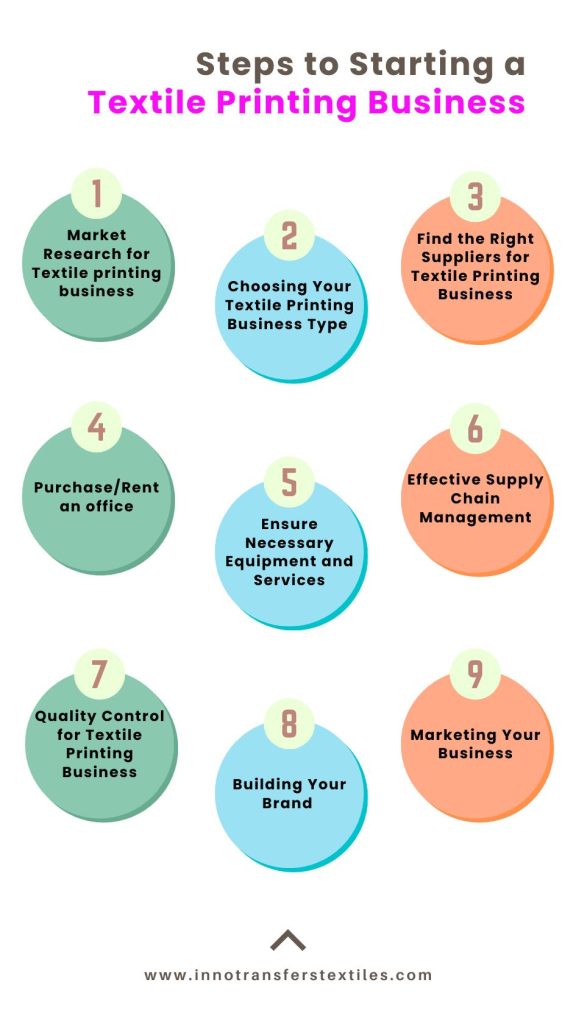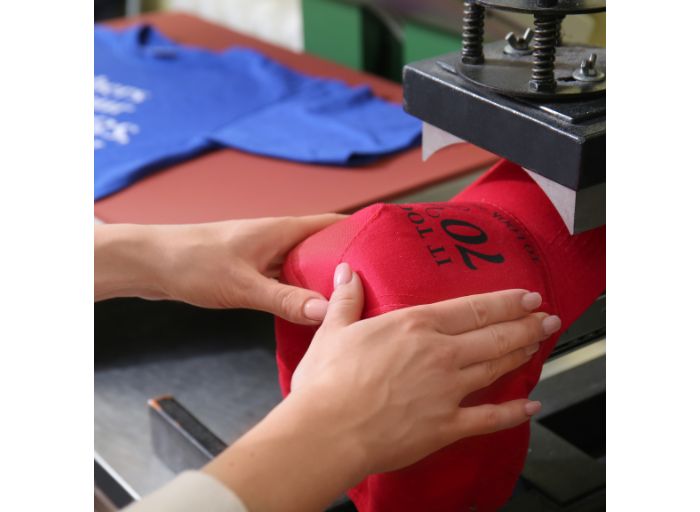Starting a textile printing business can be an exciting venture for creative entrepreneurs with a passion for fabrics and design. With the increasing demand for Direct to Garment printing, and custom-designed textiles, this industry offers a promising opportunity for those seeking to turn this into a profitable business.
According to a recent report of Future Market Insights from 2022 to 2032, the global direct-to-garment printing market is projected to expand from a value of US$ 822.1 Mn in 2022 to US$ 1,820.1 Mn. From GlobeNewswire, it is estimated that The Global Commercial Printing Market was valued at USD 411. 99 billion in 2020, and it is projected to be worth USD 472. 35 billion by 2026. This article will guide you through the essential steps to successfully start your own textile printing business.
Steps to Starting a Textile Printing Business

Market Research for Textile printing business

Before diving into any business, conducting thorough market research is crucial. Analyze the textile printing market to identify potential competitors, target customers, and emerging trends. Understanding the demand for specific designs and fabrics will help you position your business effectively. You have to do a SWOT analysis of the business before going through the highly competitive apparel market. You can analyze your competitor’s pricing strategy, marketing tactics, and customer reviews to understand their competitive position and identify opportunities for differentiation. There are a few resources that can help you get started in your research work. PRINTING United Alliance is a good resource for information on the textile printing industry, as well as information on textile printing education and training.
You need to Research industry trends What are the latest trends in garment printing? What are the emerging technologies and innovations? For that you can visit different Exhibitions, and trade fairs you can find what Trade fairs are happening currently on our events page. Staying updated on industry trends allows you to adapt your business to changing customer expectations and market demands. You can check the Digital Textile Printing Market Size, Share & Trends Analysis Report By Printing Process by clicking here.
Choosing Your Textile Printing Business Type
There are many different types of textile printing businesses in the current market. Some of the most common types include:
- Custom textile printing businesses
- Retail textile printing businesses
- Wholesale textile printing businesses
- Print-on-demand textile printing businesses
Above these custom textile printing business is the latest trend and the young generations are more likely to go for custom-made apparel. You can go with our cutting-edge printing technology Innoprinter and innotransfers to fulfill any type of printing needs.

Textile printing encompasses a wide range of products and styles. To stand out in the market, it’s essential to choose the right business type that aligns with your expertise and interests. Consider focusing on specific fabric types, like organic or sustainable materials, or catering to particular industries such as fashion, home decor, or sportswear. There are various textile printing methods, each offering unique results. Understanding these methods will help you determine the best approach for your designs. Some common techniques include screen printing, digital printing, heat transfer, and block printing.
Find the Right Suppliers for Textile Printing Business
Investing in high-quality printing equipment and materials is vital for producing exceptional prints. Research and select the right suppliers who can provide you with high-quality materials and machinery, inks, and fabrics based on your chosen textile printing business type. You can talk to other textile printing businesses to see if they have any recommendations for suppliers.

You can also ask your local chamber of commerce or trade association for recommendations. You can go with Innotransfers as we are a leading European business group, manufacturers of high-quality textile transfers, and innovative textile transfer printing machinery for the textile industry. Our latest Innoprinter heat transfer printing machine allows us to deliver from the smallest order to the largest order in a very efficient time.
.
Purchase/Rent an office

Creating an efficient and organized office is essential for smooth operations. Even if you initially plan to have an exclusive B2B business model or an online retail business, you will still need a physical space to register your business and to store your products. Consider factors like space requirements, ventilation, and safety measures when setting up your textile printing workspace. For Running a legal and compliant business Obtain all the necessary permits and licenses required to operate your textile printing business.
We have researched the legal documents required for renting an office and it can vary depending on your location and the specific terms of the lease. However, some common documents include:
- Lease Agreements
- Proof of Ownership
- Business Registration
- Government-issued ID
- Utility Bills
- Insurance
- Subletting Agreement
- Stamp Duty
Additional Documents:
- Building plan
- No Objection Certificate (NOC)
- Environmental clearance certificate
It is important to consult with a lawyer to ensure that all necessary legal documents are in place and that the lease agreement is fair and protects both parties.
Ensure Necessary Equipment and Services
The type of equipment you need for your textile printing business will depend on the type of textile printing business you have. You may need to purchase specialized printers, such as inkjet, laser, screen, heat transfer, or offset printers. You will also need design software and a compatible computer system.

Some popular graphics design software in the current market for printing include
- Adobe Photoshop
- Adobe Illustrator
- CorelDRAW
- InDesign
- Affinity Designer
In addition, you will need accounting software for inventory, invoicing, and tracking expenses. You should also have cutting equipment for paper or vinyl and an assortment of inventory available to meet customer needs.
Effective Supply Chain Management

Efficiently managing orders and production is vital for meeting customer expectations and maintaining a smooth workflow. The textile printing industry has different delivery expectations for different types of orders. Such as
- B2B orders
- Bulk orders
- Online print-on-demand orders
- Regular e-commerce orders
All these have different requirements in terms of speed, cost, and reliability. It is important to create a suitable supply chain for your business model and to ensure that you have effective and efficient transportation.
Quality Control for Textile Printing Business
Maintaining strict quality control measures will help establish your business as a trusted provider of textile prints. Testing and Inspecting Prints regularly for quality and conduct testing to ensure durability and colorfastness.

Some top Certifications and Standards for Textile Printing Businesses are
- International Organization for Standardization (ISO) 9001
- Global Organic Textile Standard (GOTS)
- Oeko-tex standard 100
- The Better Cotton Initiative (BCI)
- Worldwide Responsible Apparel Production (WRAP)
Building Your Brand

Establishing a strong brand identity is essential for gaining recognition and customer loyalty. Define your brand’s vision, mission, and values. Design a unique brand identity that represents your business and resonates with your target audience.
Create a consistent brand message for your brand it is the story about your company. It should be clear, and concise, and communicate your company’s value proposition. Make sure your brand message is consistent across all your marketing materials, including your website, social media, and advertising.
For Example, Innotransfers brand message is Join the Printing Revolution. This influences our customers to use our innovative printing technologies as Innotransfers offers a cutting-edge range of printing technologies designed to unlock the creative potential and revolutionize the printing experience. Whether you’re a seasoned professional or just starting out.
You also need to Craft a visually appealing logo that encapsulates the essence of your brand. Your logo will become the face of your textile printing business, so invest time and effort into its creation.
Marketing Your Business
Effectively marketing your textile printing business is crucial for attracting customers and generating sales. In today’s competitive market, you need to use both traditional and digital marketing channels.

For textile printing businesses, traditional marketing can be a highly effective way to reach your target audience and build brand awareness. Here are some key strategies to consider:
1. Leverage Print Advertising:
- Targeted publications: Advertise in magazines, newspapers, and trade journals relevant to your ideal customer base. This could include fashion magazines, local community newspapers, or publications catering to specific industries or hobbies.
- Direct mailers: Send personalized mailers showcasing your printing services and highlighting special offers. This allows you to target specific demographics and neighborhoods with relevant messaging.
- Brochures and flyers: Create visually appealing brochures and flyers outlining your services and pricing. Distribute them at relevant events, trade shows, or local businesses frequented by your target audience.
2. Get Creative with Out-of-Home Advertising:
- Billboards and bus ads: Capture attention with eye-catching visuals and concise messaging on billboards or bus stop advertisements. This can be especially effective in high-traffic areas frequented by your target audience.
- Vehicle wraps: Turn your company vehicles into mobile billboards. Design eye-catching wraps showcasing your brand and services.
- In-store displays: Partner with local businesses to showcase your work in their stores. This could include displaying printed garments or creating custom signage.
3. Build Relationships Through Events and Sponsorships:
- Participate in local events and trade shows: Network with potential customers and showcase your printing capabilities at industry events, craft fairs, or community festivals.
- Sponsor local events or teams: Increase brand visibility and build goodwill by sponsoring local sports teams, cultural events, or charitable initiatives.
- Host workshops or demonstrations: Offer free workshops or demonstrations on garment printing techniques to attract potential customers and build your reputation as an expert.
4. Utilize Traditional Media Channels:
- Radio and podcast advertising: Reach a wider audience through targeted radio ads or by sponsoring relevant podcasts.
- Public relations campaigns: Generate positive media coverage by issuing press releases, pitching stories to journalists, and participating in industry awards.
5. Don’t Forget Print Marketing Materials:
- Business cards: Invest in high-quality business cards that reflect your brand identity and clearly communicate your contact information.
- Packaging and labels: Use branded packaging and labels to create a professional and consistent brand experience for your customers.
- Signage and banners: Create eye-catching signage and banners to attract attention to your shop or booth at events.
A professional and user-friendly website is essential for showcasing your designs, products, and contact information. You should also utilize social media, effective SEO, and other digital marketing channels to leverage your textile printing business.
In today’s digital landscape, a strong online presence is crucial for any garment printing business. Here are some key strategies to conquer the digital realm and reach your target audience:
1. Build a Compelling Website:
- Visually appealing: Invest in a website with a clean, modern design and high-quality visuals showcasing your work.
- User-friendly interface: Ensure your website is easy to navigate, with clear calls to action prompting users to contact you or place an order.
- Mobile-optimized: Make sure your website is optimized for mobile devices, as a significant portion of your audience will be browsing on their phones.
- SEO-friendly: Utilize relevant keywords and optimize your website content to rank higher in search engine results.
2. Master the Art of Social Media:
- Identify the right platforms: Choose social media platforms where your target audience spends their time, such as Instagram, Pinterest, and Facebook.
- Create engaging content: Share captivating images and videos of your printed garments, offer design tips, and host interactive contests or giveaways.
- Run targeted ads: Leverage social media advertising platforms to reach specific demographics and interests with laser-focused campaigns.
- Engage with your audience: Respond to comments and messages promptly, answer questions, and participate in relevant conversations.
3. Email Marketing for Building Loyalty:
- Build an email list: Encourage website visitors and customers to subscribe to your email list by offering exclusive discounts or early access to new designs.
- Segment your audience: Send personalized email campaigns based on customer interests, purchase history, and other relevant data.
- Offer valuable content: Provide informative newsletters, design tips, and special offers to keep your audience engaged.
- Track your results: Monitor your email open rates, click-through rates, and conversion rates to optimize your email marketing strategy.
4. Partner with Influencers:
- Identify relevant influencers: Collaborate with fashion bloggers, social media influencers, or other individuals who resonate with your target audience.
- Create co-branded content: Partner with influencers to design exclusive collections, host online giveaways, or promote your services to their followers.
- Leverage influencer marketing platforms: Utilize platforms like HypeAuditor or Traackr to identify relevant influencers and measure the success of your influencer marketing campaigns.
5. Embrace the Power of Content Marketing:
- Create a blog: Publish informative and engaging blog posts on topics relevant to your audience, such as garment printing trends, design inspiration, and tips for choosing the right printing techniques.
- Develop video tutorials: Offer video tutorials showcasing your printing process, design tips, or creative garment customization techniques.
- Publish guest posts on industry blogs: Reach a wider audience by contributing guest posts to established blogs and websites in your niche.
By leveraging different marketing platforms, you can showcase your work, engage with your audience, and run targeted ad campaigns. This will help you reach a wider audience and increase your chances of success.
.
Conclusion
Starting a textile printing business requires careful planning, creativity, and dedication. By following the steps outlined in this article, you can lay a solid foundation for a successful venture in the textile printing industry. Starting a textile printing business can be both creatively fulfilling and financially rewarding. With a well-defined business type, quality prints, and effective marketing, your business can thrive in the competitive textile industry. Remember to stay up-to-date with industry trends and continuously innovate to keep your offerings fresh and appealing to customers. Good luck on your entrepreneurial journey!
FAQs
How much initial investment do I need to start a textile printing business?
Starting a textile printing business requires a moderate initial investment, including equipment, materials, and marketing costs. The exact amount will depend on your business’s scale and chosen printing method.
Can I start a textile printing business from home?
Yes, many entrepreneurs begin their textile printing journey from home. Ensure you have enough space for your equipment and comply with local regulations.
Do I need design skills to start this business?
While design skills are beneficial, you can collaborate with freelance designers or hire in-house designers to create unique prints.
How can I promote my textile printing business locally?
Attend local craft fairs, collaborate with nearby businesses, and utilize social media to reach your local audience.


These are the panels that are hung above the windows. Their fundamental take dream is to have the funds for privacy to their users. But textile buying house in pakistan are used for various purposes by everyone. Thats why these are altogether beneficial for habitat interiors or others. Nowadays, mostly used as curtain design for dwelling interiors.